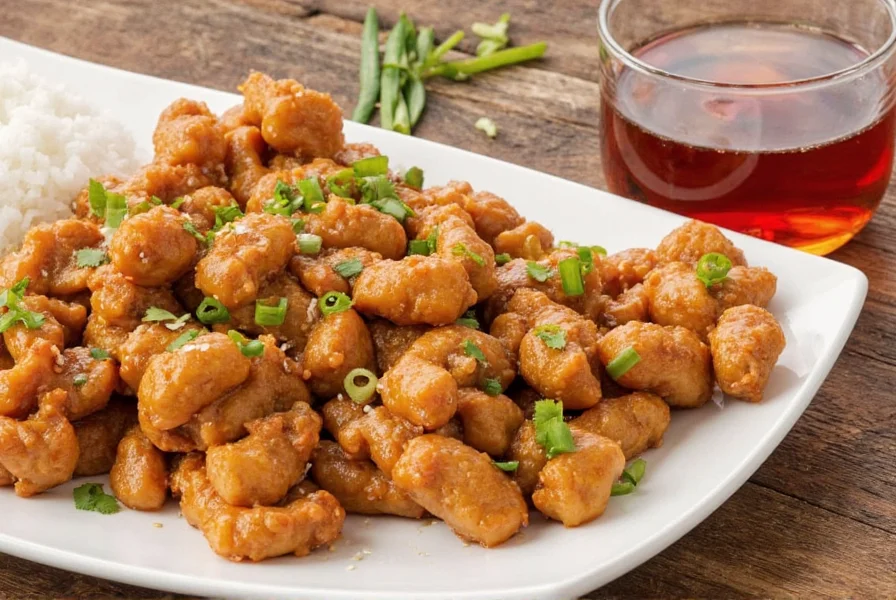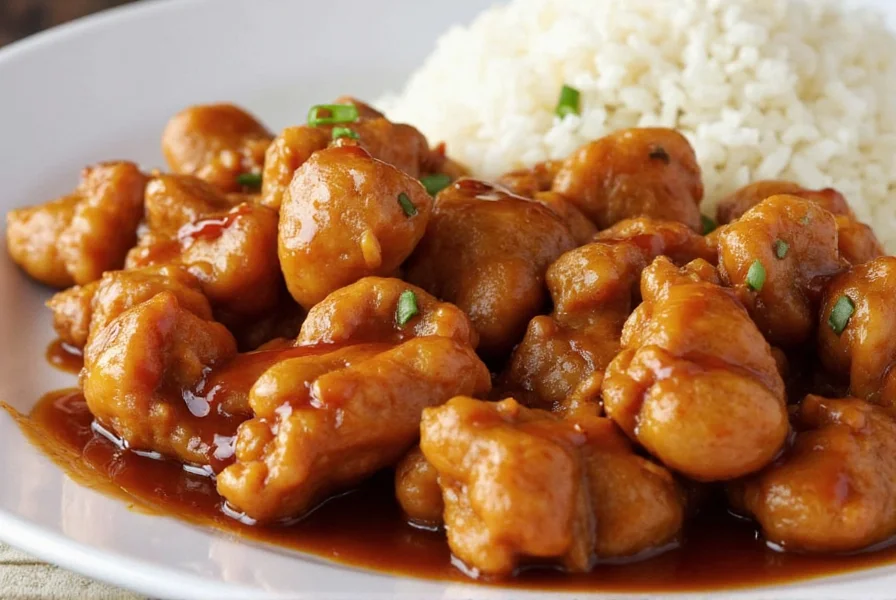When you order Black Pepper Chicken at Panda Express, you're getting a distinctly American interpretation of a Chinese culinary classic. This popular menu staple has become a favorite among customers seeking bold flavors without overwhelming spice. Understanding what makes this dish unique requires examining its ingredients, preparation method, and how it differs from traditional Chinese black pepper chicken recipes.
What Makes Panda Express Black Pepper Chicken Unique
Unlike authentic Chinese black pepper chicken which typically features whole chicken pieces with bones, Panda Express serves boneless white meat chicken cubes. The Americanized version incorporates bell peppers and onions not commonly found in traditional preparations, creating a colorful presentation that appeals to Western palates. The sauce formulation balances cracked black pepper heat with subtle sweetness and umami notes from soy sauce and other seasonings.
Ingredients Breakdown and Preparation
Panda Express Black Pepper Chicken contains the following primary ingredients:
| Ingredient | Role in Dish | Notable Characteristics |
|---|---|---|
| White meat chicken | Protein base | Boneless, bite-sized cubes |
| Cracked black pepper | Signature flavor | Moderate heat, not spicy |
| Bell peppers | Texture and color | Red and green varieties |
| Onions | Savory component | White onions, thinly sliced |
| Soy sauce blend | Umami foundation | Contains wheat, not gluten-free |
The preparation involves flash-frying the chicken before combining it with the vegetables and sauce. This cooking technique creates the characteristic wok hei (breath of the wok) flavor while maintaining the chicken's tenderness. The black pepper used is coarsely cracked rather than ground, providing bursts of flavor throughout the dish.
Flavor Profile Analysis
Many customers wonder about the heat level of Panda Express Black Pepper Chicken. Despite the name, this dish delivers moderate black pepper flavor rather than significant spiciness. The heat comes from the essential oils in cracked black peppercorns, not from chili peppers or hot sauces. The flavor profile balances:
- Pungency - from freshly cracked black pepper
- Savory umami - from soy-based sauce components
- Subtle sweetness - enhancing the overall flavor without being sugary
- Vegetable freshness - from crisp bell peppers and onions
The texture features tender chicken pieces with slightly crisp-tender vegetables, creating a satisfying mouthfeel that distinguishes it from other Panda Express offerings like the more sauce-heavy Orange Chicken.
Nutritional Information and Dietary Considerations
A standard serving of Panda Express Black Pepper Chicken (one entrée) contains approximately:
- 330 calories
- 26g protein
- 39g carbohydrates
- 9g fat
- 1,190mg sodium
For those with dietary restrictions, it's important to note that this dish contains gluten (from soy sauce) and is not suitable for gluten-free diets. The high sodium content makes it less ideal for those monitoring sodium intake, though it remains one of the lower-calorie protein options on the Panda Express menu compared to items like Honey Walnut Shrimp or Beijing Beef.
How It Compares to Authentic Chinese Black Pepper Chicken
Traditional Chinese black pepper chicken (黑胡椒鸡) differs significantly from Panda Express's version. Authentic preparations typically:
- Use bone-in chicken pieces
- Feature minimal vegetables, often just garlic and ginger
- Contain black pepper as the dominant flavor without added sweetness
- May include mushrooms, which Panda Express omits
- Have a thinner, more oil-based sauce rather than the thicker American version
The Panda Express adaptation represents what food historians call "American Chinese cuisine"—a distinct culinary tradition that evolved to suit American tastes while maintaining loose connections to Chinese cooking techniques. This explains why customers familiar with authentic Chinese restaurants might find the Panda Express version noticeably different.
Serving Suggestions and Menu Pairings
To maximize your Black Pepper Chicken experience at Panda Express, consider these pairing recommendations:
- Steamed white rice - provides a neutral base that complements the bold flavors
- Super Greens - balances the richness with fresh vegetable notes
- Hot mustard - adds an extra dimension for those who enjoy more heat
- Coconut water - refreshes the palate between bites
For a complete meal, many regular customers recommend the Black Pepper Chicken with mixed vegetables combination, which adds broccoli and other seasonal vegetables to create a more balanced nutritional profile.

Common Misconceptions Addressed
Several misconceptions surround Panda Express Black Pepper Chicken. First, despite the name, it's not particularly spicy—it delivers pepper flavor rather than heat. Second, it doesn't contain any actual black pepper sauce as a pre-made component; the flavor comes from freshly cracked pepper incorporated during cooking. Third, while it shares a name with Chinese black pepper chicken, the preparation and ingredients differ substantially from traditional recipes found in China or authentic Chinese restaurants.
Understanding these distinctions helps set appropriate expectations when ordering. The dish represents Panda Express's interpretation of Chinese cuisine adapted for American tastes, prioritizing approachable flavors and consistent preparation across all locations.

Frequently Asked Questions
Is Panda Express Black Pepper Chicken spicy?
No, Panda Express Black Pepper Chicken is not spicy in the chili pepper sense. It has a moderate black pepper flavor that provides pungency rather than heat. The dish uses cracked black pepper for flavor, not chili peppers or hot sauces, making it suitable for those who prefer bold flavors without significant spiciness.
Does Panda Express Black Pepper Chicken contain gluten?
Yes, Panda Express Black Pepper Chicken contains gluten. The soy sauce used in the preparation includes wheat, making the dish unsuitable for gluten-free diets. Those with gluten sensitivities should consider alternative menu items like plain steamed chicken without sauce.
How does Panda Express Black Pepper Chicken compare to Orange Chicken?
Black Pepper Chicken features savory, peppery flavors with moderate heat from black pepper, while Orange Chicken is sweet and tangy with citrus notes. Nutritionally, Black Pepper Chicken has fewer calories (330 vs 490) and less sugar than Orange Chicken. The texture also differs, with Black Pepper Chicken having more visible vegetables and a thinner sauce coating.
Is Black Pepper Chicken considered healthy at Panda Express?
Compared to other Panda Express menu items, Black Pepper Chicken is one of the healthier protein options with 26g protein and 330 calories per serving. However, it contains 1,190mg sodium, which is relatively high. For a more balanced meal, pair it with steamed rice and Super Greens rather than fried rice or additional high-sodium sides.
Does Panda Express Black Pepper Chicken contain mushrooms?
No, Panda Express Black Pepper Chicken does not contain mushrooms. This differs from many authentic Chinese black pepper chicken recipes which often include mushrooms. The Panda Express version focuses on chicken, bell peppers, onions, and the signature black pepper sauce without mushroom components.











 浙公网安备
33010002000092号
浙公网安备
33010002000092号 浙B2-20120091-4
浙B2-20120091-4